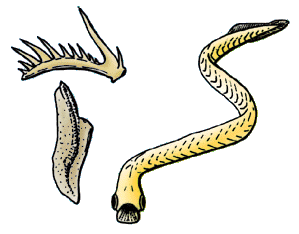
During the geologic period known as the Permian – beginning about 300 million years ago – Earth teemed with life. As the website ScienceNewsforStudents.org explained:
… nearly all of Earth’s landmasses had clumped into one mega-continent. Its name: Pangaea … On land, insects buzzed and crawled, including primitive dragonflies and cockroaches. Big, plant-eating reptiles and amphibians grazed its forests. The oceans were ruled by fish. Coral reefs thrived. Trilobites scuttled along the seafloor.
Then 252 million years ago, something happened to cause the greatest mass extinction in Earth’s history. Over a few hundreds of thousands of years, the catastrophe killed off more than 95 percent of life on Earth. Scientists call it the Great Dying. It cleared the way for the rise of the age of dinosaurs. Scientists have debated the Great Dying’s cause, although, in recent years, many have begun to settle on the idea that volcanic eruptions were the primary cause. And now a new study – based on the discovery of mercury buried in ancient rocks – provides the strongest evidence yet that volcanoes did cause the Great Dying. Paleontologists with the University of Cincinnati and the China University of Geosciences said they found a spike in mercury in the geologic record at nearly a dozen sites around the world, providing what they called “persuasive evidence” that volcanic eruptions were to blame for this global cataclysm.
The idea is that volcanic eruptions ignited vast deposits of coal, releasing mercury vapor high into the atmosphere. Eventually, these scientists say, the mercury rained down into the marine sediments, and it’s the analysis of those ancient sediments today, now trapped in rock, that provides the basis for this new study. The scientists said the mercury created:
… an elemental signature of a catastrophe.
The study was published April 5, 2019 in the peer-reviewed journal Nature Communications. Lead author Jun Shen at the China University of Geosciences explained:
Volcanic activities, including emissions of volcanic gases and combustion of organic matter, released abundant mercury to the surface of the Earth.
Thomas Algeo of University of Cincinnati added:
Mercury is a relatively new indicator for researchers. It has become a hot topic for investigating volcanic influences on major events in Earth’s history.
The volcanic eruptions happened in a specific place on Earth, in a volcanic system called the Siberian Traps, in what’s now central Russia. A statement from these scientists said:
Many of the eruptions occured not in cone-shaped volcanoes but through gaping fissures in the ground. The eruptions were frequent and long-lasting and their fury spanned a period of hundreds of thousands of years.

How did volcanoes in a specific place on Earth cause 95 percent of Earth’s creatures to disappear? These scientists explained that the volcanoes lifted as much as 3 million cubic kilometers (720,000 cubic miles) of ash high into the air over this extended period. They said:
To put that in perspective, the 1980 eruption of Mount St. Helens in Washington sent just 1 cubic kilometer [.24 cubic mi] of ash into the atmosphere, even though ash fell on car windshields as far away as Oklahoma.
It’s thought that the Siberian Traps eruptions spewed so much material in the air, particularly greenhouse gases, that it warmed the planet by an average of about 10 degrees Celsius (18 degrees Fahrenheit). The scientists explained:
The warming climate likely would have been one of the biggest culprits in the mass extinction … But acid rain would have spoiled many bodies of water and raised the acidity of the global oceans. And the warmer water would have had more dead zones from a lack of dissolved oxygen …
Stretching over an extended period, eruption after eruption prevented the Earth’s food chain from recovering.
Read more about this research from University of Cincinnati
Bottom line: The discovery of mercury in ancient rock at locations around the world supports the idea that volcanic eruptions caused the Great Dying, a mass extinction 252 million years ago that killed 95 percent of life on Earth.











